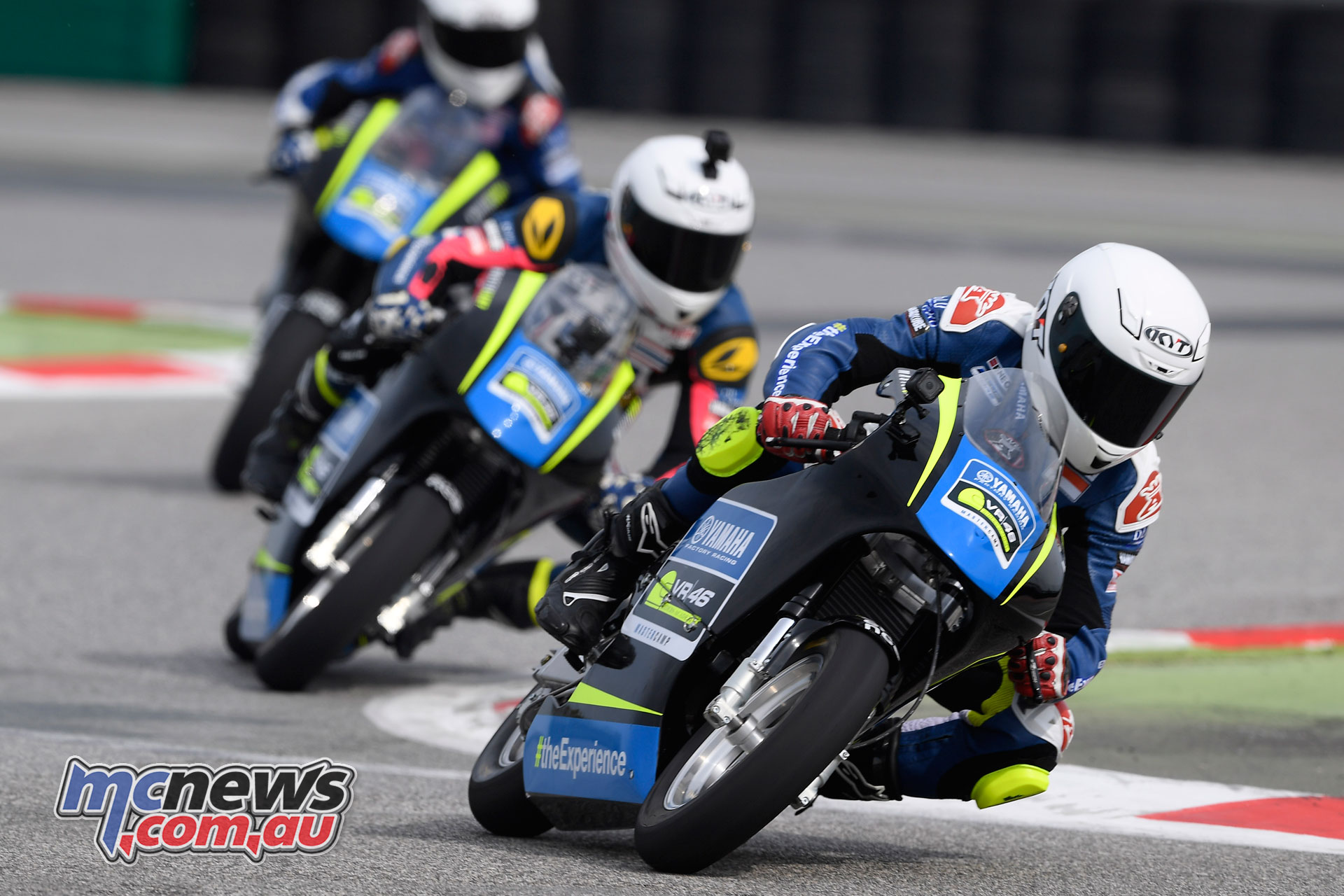Desmosedici Stradale – The new Ducati V4 engine
The counterrotating crankshaft has advantages during both acceleration and braking. Of course, this layout demands the addition of the so-called ‘jackshaft’ (*) to transfer crankshaft drive through the gearbox to the rear wheel so it turns the right way.
* The jackshaft adds an extra transmission element to the crankshaft-wheel connection system. This needs to be taken into consideration when establishing crankshaft power if the latter is obtained from measurements made at the wheel. During both homologation and measurement on acceleration test benches it is, therefore, necessary to consider an efficiency or, in any case, an additional coefficient that is, by law, fixed at 0.98.
The 90-degree V-layout evens up first order forces naturally without having to resort to a balancing countershaft to eliminate vibration, a solution that, as is known, increases weight and drains power.
Ample space inside the V provides room for both the water pump and a large airbox (12.8 litres), that lets the Desmosedici Stradale breathe better.
Desmosedici Stradale is designed to be banked rearward 42°, just like the Ducati engines used in MotoGP. This optimises weight distribution, allows for larger radiators and brings the swingarm pivot as far forward as possible.
Moreover, the Desmosedici Stradale has been designed as a structural chassis element. The main frame attachment points have been incorporated in the front of the upper crankcase half and in the rear cylinder bank head. What’s more, the crankcase acts as a rear suspension and swingarm attachment point.
Weighing in at 64.9 kg, the Desmosedici Stradale is just 2.2 kg heavier than the 1285cc Superquadro twin. Engine casings are made of gravity die cast aluminium and are coupled horizontally. The upper crankcase half incorporates the four Nikasil-coated aluminium cylinder liners ensuring wear protection and low friction.
The 81mm diameter pistons that slide inside the liners have two low-attrition compression rings and an oil ring. Made of moulded aluminium, the pistons feature “box in box” technology: this contains both skirt height and below-chamber thickness, helping to reduce attrition and inertial loads while maintaining the necessary strength and stiffness.
Racing-derived design is also underscored by a high compression ratio of 14:1. The pistons are coupled to forged steel con rods with a centre-to-centre of 101.8 mm. Mounted on brass bushings, the crankshaft rotates on three supports and is made of nitrided steel with crank pins ground twice over and offset at 70° as on the Desmosedici engines that compete in MotoGP.
This particular shaft geometry, combined with the V engine layout, allows for a special “Twin Pulse” ignition sequence.
To limit weight, all engine casings are made of die cast magnesium. The same material has been used to make the cam covers, the oil sump, the alternator cover and the two-piece clutch cover.
Twin Pulse
A combination of 70° crank pin offset and 90-degree V layout generates what Ducati calls a “Twin Pulse” firing order because it’s as if the engine were reproducing the firing sequence of a twin-cylinder. The distinctiveness lies in the fact that the two left-hand cylinders fire closely together, as do the two right-hand ones. In the timing chart, the ignition points are, then, at 0°, 90°, 290° and 380°. It’s this particular firing order
makes the V4 sound like a MotoGP Desmosedici.
In practice, if we imagine a cycle starting from 0°, the first cylinder to fire is the front one on the alternator side. After just 90° of rotation, the rear cylinder on the same side fires. There then follows an interval in which the engine generates no drive torque until the two cylinders on the clutch side fire, again just 90° apart. In addition to a great exhaust rumble Twin Pulse ignition sequence provides a power delivery that Ducati MotoGP riders deem unbeatable.
Variable Intake System
The Desmosedici Stradale engine takes in air through four oval throttle bodies (52 mm diameter equivalent), connected to variable-height air intake horns, featured for the first time on a Ducati engine. This solutio optimises cylinder intake across the rev range, giving major advantages in terms of power delivery and handling.
As rpm and rider-requested power vary, the air intake horns take on a configuration that lengthens or shortens the ducts, optimising the fluid dynamics of the pressure waves that run along the duct itself.
Controlled by the ECU, the system consists of two stages: a fixed horn on the throttle body and a mobile one that is moved along steel guides by an electric motor. When the latter is lowered, it comes into contact with the short horn, geometrically lengthening the duct. When raised, the fluid dynamics involve only the fixed lower horn and the engine configuration is characterised by a very short duct.
Each throttle body has two injectors: a sub-butterfly one for low-load use and another above it that comes into play when maximum engine performance is required. The throttle bodies of each cylinder bank are moved by a dedicated electric motor. Thanks to the full Ride by Wire system, this allows complex electronic control strategies and modulation of engine ‘feel’ according to the selected riding mode.
Latest-generation Desmodromic system
As on all Ducati engines, the Desmosedici Stradale sees Desmodromic design playing a pivotal performance role. On the Desmosedici Stradale, the Desmodromic system uses fully redesigned, miniaturised components that have allowed for the construction of very small cylinder heads, achieving a degree of sophistication, lightness and compactness never before seen on a Ducati.
New spark plugs – smaller than standard models – also help keep the heads compact. The four Desmosedici Stradale engine camshafts control the sixteen valves: valve diameters are 34 mm diameter on intakes and 27.5 mm on exhausts, values decidedly on the high side given the 81 mm bore. The valve seats are made of sintered steel.
“Desmo” system the valves are closed mechanically with the same level of accuracy as they’re opened. This allows the steep cam profiles and radical cam timings that optimise
intake and exhaust fluid dynamics to provide higher engine performance.
The camshafts are controlled by two “silent” timing chains. At the front, the chain drives the intake camshaft which, in turn, transmits drive to the exhaust camshaft via a pair of cogs (hybrid chain-cog timing). On rear timing, instead, the chain drives the exhaust camshaft, which transmits drive to the intake camshaft.
Front cylinder timing is controlled by the chain on the right-hand side of the engine, turned by the crankshaft via a gear obtained on the primary drive pinion. The one that controls rear cylinder timing is on the left-hand side of the engine and is driven by a monobloc gear on the crankshaft. Each cylinder head has an “anti-knocking” sensor that
optimises spark advance to prevent any combustion shock.
Semi-dry sump lubrication
As on MotoGP engines, the Desmosedici Stradale uses semi-dry sump lubrication with delivery and return stages that ensure effective lubrication of all moving parts at all times.
The oil circulation system consists of four pumps: one delivery lobe pump and three recovery pumps. One of the latter, a gear pump, draws oil from the heads via two ducts while the other two lobe pumps ensure efficient oil recovery under all conditions, keeping the crankcase zone under the pistons in a controlled, constant low pressure state and thus reducing airing losses (i.e. power absorption caused by the aerodynamic resistance exerted by the air and splashing of the oil in the con rod casing).
The oil tank – which also acts as a filter housing – is in a magnesium sump mounted underneath the crankcase and connected to the gearbox but separate from the crankcase. A dedicated radiator, attached just below the water radiator, cools the oil.
Housed in the engine ‘V’, the water pump is operated by a shaft, in turn driven by a gear train. This positioning solution is designed to minimise circuit size, boost efficiency and optimise engine weight.
Gearbox and clutch
The 6-speed gearbox is specially designed for the Desmosedici Stradale engine and features a rotary gear sensor to ensure optimal operation with Ducati Quick Shift (DQS) up & down.
The sensor assesses the position of the gear shift drum and, consequently, of the gear shift forks, with extreme accuracy to ensure precise gear selection. This, then, allows for a strategy that can restore torque transmission only once the gear change has been completed, thus preventing undue gear mesh stress so shifts are always complete, precise and swift.
The hydraulically controlled wet clutch has 11 driving plates and features a progressive self-servo mechanism that compresses the friction plates when under drive from the engine without requiring any extra effort from the rider to release the clutch.
In sport riding conditions, the same mechanism reduces pressure on the friction plates, enabling a pure racing “slipper” action and reducing rear end destabilisation during aggressive down-shifting, with the added benefit of a super-responsive lever.
Long maintenance intervals
While performance levels surpass even those of the Superquadro, the valve clearance inspection and adjustment (Desmo Service) interval remains at 24,000 km (15,000 miles), while general service intervals remain unchanged at 12 months/12,000 km (7,500 miles).























